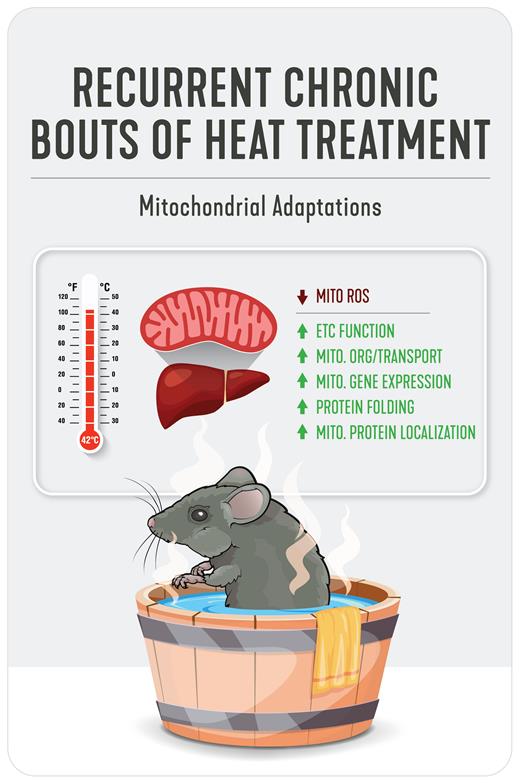The intrinsic heterogeneity of metabolic dysfunction-associated fatty liver disease (MASLD) and the intricate pathogenesis have impeded the advancement and clinical implementation of therapeutic interventions, underscoring the critical dema
Tag: Fatty Liver Disease
Enhancing the functionality of mesenchymal stem cells: An attractive treatment strategy for metabolic dysfunction-associated steatotic liver disease?
The intrinsic heterogeneity of metabolic dysfunction-associated fatty liver disease (MASLD) and the intricate pathogenesis have impeded the advancement and clinical implementation of therapeutic interventions, underscoring the critical dema
Innovative mesenchymal stem cell treatments for fatty liver disease
The incidence of non-alcoholic fatty liver disease (NAFLD) and alcohol-associated liver disease (ALD) is increasing year by year due to changes in the contemporary environment and dietary structure, and is an important public health problem
New research explores the urea cycle’s strong connection to fatty liver disease
An Indiana University School of Medicine physician scientist is making strides in understanding the molecular origins of fatty liver disease, a leading cause of liver failure in the United States.

Rutgers Names Nationally Recognized Clinician-Scientist in Obesity and Nonalcoholic Fatty Liver Disease as New Chair of Medicine
Jeanne M. Clark, a board-certified internal medicine physician with extensive research experience and a nationally renowned expert in the epidemiology and treatment of obesity, will join Rutgers Robert Wood Johnson Medical School as the Henry Rutgers Professor and chair of the Department of Medicine.
Current perspectives on mesenchymal stem cells as a potential therapeutic strategy for non-alcoholic fatty liver disease
Non-alcoholic fatty liver disease (NAFLD) has emerged as a significant health challenge, characterized by its widespread prevalence, intricate natural progression and multifaceted pathogenesis. Although NAFLD initially presents as benign fa
Two medication classes reduced cardiovascular and liver events in people with type 2 diabetes
GLP-1 receptor agonists (GLP-1s) and SGLT-2 inhibitors lower the risk of major cardiovascular events like heart attacks and severe liver complications compared to other diabetes treatments, according to data being presented Sunday at ENDO 2024, the Endocrine Society’s annual meeting in Boston, Mass.
Hot flashes in menopausal women may signal increased risk for heart and metabolic issues
Women experiencing moderate-to-severe vasomotor symptoms face a three times greater risk for metabolic-dysfunction-associated steatotic liver disease (MASLD) compared to those with mild symptom severity, according to research being presented Monday at ENDO 2024, the Endocrine Society’s annual meeting in Boston, Mass.
Childhood sedentariness may cause premature liver damage in young adulthood
Children who are sedentary for more than six waking hours a day have a significantly increased risk of severe fatty liver disease and liver cirrhosis by young adulthood, a new study finds. The research findings will be presented Saturday at ENDO 2024, the Endocrine Society’s annual meeting in Boston, Mass and published in Nature’s npj Gut and Liver.
Semaglutide suitable for people with HIV and fatty liver disease
A study of persons with HIV (PWH) and metabolic dysfunction–associated steatotic liver disease, also known as ‘fatty liver disease,’ (MASLD) found that semaglutide was highly effective at reducing liver fat and cardiovascular disease risk in this population.
UChicago Medicine helps bring first-of-its-kind drug for metabolic liver disease to the clinic
Resmetirom (Rezdiffra) is the first drug approved for treating MASH, an advanced form of fatty liver disease. UChicago Medicine experts contributed to a recent clinical trial and will begin incorporating the drug into liver disease treatment regimens for eligible patients.
Oregon State researchers uncover mechanism for treating dangerous liver condition
A study spearheaded by Oregon State University has shown why certain polyunsaturated fatty acids work to combat a dangerous liver condition, opening a new avenue of drug research for a disease that currently has no FDA-approved medications.
Genetic variation with MASLD reveals subtypes and potential therapeutic avenues
A study reveals genetic subtypes, biomarkers, gene and pathway targets for the development of new treatments for this liver disease
Surgery most effective treatment of metabolic liver disease
Metabolic (bariatric) surgery is more effective than medications and lifestyle interventions for the treatment of advanced non-alcoholic fatty liver disease.
Presentations Showcase Latest Pediatric GI Research
Is unsedated transnasal esophagoscopy safe for patients with cirrhosis? How good is ultrasound at assessing fibrosis in children with fatty liver disease? These are just a few of the questions addressed in presentations this past fall by faculty from the Division of Gastroenterology, Hepatology and Nutrition at Children’s Hospital Los Angeles.
Trigger for world’s most common liver disease identified
University of Virginia School of Medicine researchers have discovered a key trigger for non-alcoholic fatty liver disease, a mysterious condition that causes fat to build up in the liver for no clear reason.
Boosting Omega-3 Production Could Help Cut Chronic Inflammation and Fatty Liver Disease
Rockville, Md. (January 25, 2022)—A new study from researchers at Laval University in Quebec, Canada, shows that genetically increasing omega-3 fatty acid production, without direct gut microbiota contact, improves the balance of insulin and glucagon (glucose balance) in obese mice.…
UT Southwestern immunologists uncover obesity-linked trigger to severe form of liver disease
UT Southwestern immunologists have uncovered a key pathogenic event prompted by obesity that can trigger severe forms of nonalcoholic fatty liver disease and potential liver failure.
Research shows fatty liver disease endangers brain health
In a study examining the link between non-alcoholic fatty liver disease (NAFLD) and brain dysfunction, scientists at the Roger Williams Institute of Hepatology, affiliated to King’s College London and the University of Lausanne, found an accumulation of fat in the liver causes a decrease in oxygen to the brain and inflammation to brain tissue – both of which have been proven to lead to the onset of severe brain diseases.
It’s all about quality: effect of dietary fat composition on liver angiogenesis and lymphangiogenesis
In light of the recent pandemic, people across the globe are increasingly becoming aware of the importance of consistent high-quality nutrition and daily exercise.
People with poor sleep behaviors may be at risk for fatty liver disease
People with sedentary lifestyles and unhealthy sleep behaviors could develop fatty liver disease, according to new research published in the Endocrine Society’s Journal of Clinical Endocrinology & Metabolism.
Lactating Mice Pass along Common Antimicrobial to Pups, Initiating Liver Damage
In mouse studies, UC San Diego researchers report that lactating mothers expose their feeding pups to triclosan, an antimicrobial commonly used in consumer products, resulting in early signs of liver damage.
Vitamin B5 May Help Weight Loss by Turning on Brown Fat
Pantothenate acid, also known as vitamin B5, stimulated the production of brown fat in both cell cultures and mice, a new study finds. “[B5] has therapeutic potential for treating obesity and type II diabetes,” researchers conclude. The study was chosen as an APSselect article for July.
Prenatal Exposure to Chemicals in Consumer and Industrial Products Is Associated With Rising Liver Disease in Children
The growing incidence of a potentially cancer-causing liver disease in children is associated with prenatal exposure to several endocrine-disrupting chemicals, Mount Sinai researchers report.
New discoveries about enzyme’s metabolic role may lead to better diabetes treatments
For the first time, a team led by UAH, a part of the University of Alabama System, has characterized the metabolic function of a phosphatase enzyme called mitogen-activated protein kinase phosphatase-2 (MKP-2), as well as the enzyme’s pathophysiology in obesity, Type 2 diabetes and nonalcoholic fatty liver disease.
Study sheds light on the benefits of exercise in fatty liver disease
Exercise supports the treatment of non-alcoholic fatty liver disease by impacting on several metabolic pathways in the body, a new study from the University of Eastern Finland shows.
Mineral Supplement Could Stop Fatty Liver Disease Progression
Results from a preclinical study add new evidence that a multi-mineral dietary supplement known as Aquamin could be a simple and effective way to reduce the long-term health consequences of non-alcoholic fatty liver disease. Aquamin, which is derived from calcified red marine algae, is rich in calcium, magnesium and 72 other minerals and trace elements.
A new study relates liquid fructose intake to fatty liver disease
A high-fat diet is not enough to cause short-term fatty liver disease. However, if this diet is combined with the intake of beverages sweetened with liquid fructose, the accumulation of fats in the liver accelerates and hypertriglyceridemia —a cardiovascular risk factor— can appear.
In Patients with Fatty Liver, Bariatric Surgery Decreases Risk of Progression of Liver Disease, Serious Heart Complications
A Cleveland Clinic study shows that patients with obesity and advanced fatty liver disease who had bariatric weight loss surgery significantly lowered their future risk of liver disease complications and serious cardiovascular disease compared with patients who did not have surgery.
World Trade Center Responders with the Greatest Exposure to Toxic Dust Have a Higher Likelihood of Liver Disease
Mount Sinai researchers have found evidence for the first time that World Trade Center responders had a higher likelihood of developing liver disease if they arrived at the site right after the attacks as opposed to working at Ground Zero later in the rescue and recovery efforts. Their study links the increase in liver disease risk to the quantity of toxic dust the workers were exposed to, which was greatest immediately after the September 11, 2001, attacks.
Wayne State researcher secures $2.3 million in NIH funding for metabolic research
A Wayne State University School of Medicine researcher has been awarded a $2.3 million grant by the National Institute of Diabetes and Digestive and Kidney Diseases of the National Institutes of Health, to support research in circadian RNA modification in metabolic disease.
Atlantic Health System and NYU Langone Health Announce Partnership on Organ Transplantation
Two of the leading names in health care in the tri-state region, New Jersey–based Atlantic Health System and New York–based NYU Langone Health, are teaming up to give patients greater access to heart and liver transplants and the coordinated, high-quality care needed to stay healthy. The clinical affiliation will partner NYU Langone’s nationally recognized transplant program with the nationally ranked Atlantic Health System Heart Care program located at Morristown Medical Center’s Gagnon Cardiovascular Institute (Morristown, NJ) and the ground-breaking liver services at Overlook Medical Center (Summit, NJ).
New Potential Therapy for Fatty Liver Disease
In a subset of patients with partial lipodystrophy and/or NASH, the hormone leptin can be leveraged as a therapeutic agent to move fat out of the liver.
Researchers find that blocking a protein in liver cells protects against insulin resistance and fatty liver disease
A new multi-institution study led by a team of researchers at the David Geffen School of Medicine demonstrated that blocking a protein called ABCB10 in liver cells protects against high blood sugar and fatty liver disease in obese mice. ABCB10 activity also prompted insulin resistance in human liver cells.

Bariatric Surgery Significantly Reduces Cancer Risk in Adults with NAFLD and Severe Obesity, Rutgers Study Finds
Bariatric surgery can significantly reduce the risk of cancer—and especially obesity-related cancers—by as much as half in certain individuals, according to a study by researchers at Rutgers Robert Wood Johnson Medical School’s Center for Liver Diseases and Liver Masses.

Heat Treatment Improves Glucose Intolerance, Insulin Resistance and Fatty Liver
Rockville, Md. (January 28, 2021)—New research shows chronic heat treatment (HT) mitigates glucose intolerance, insulin resistance and non-acholic fatty liver disease—also referred to as hepatic steatosis—in rodent models of obesity. There is currently no cure for fatty liver disease, the…
Study Explores Relationship between Dietary Macronutrients and Fatty Liver Disease Marker
Article title: Nutritional and metabolic regulation of the metabolite dimethylguanidino valeric acid–an early marker of cardiometabolic disease Authors: Jibran A. Wali, Yen Chin Koay, Jason Chami, Courtney Wood, Leo Corcilius, Richard J. Payne, Roman N. Rodionov, Andreas L. Birkenfeld, Dorit…
Sulfatase 2 Plays Role in Development of Obesity-induced Fatty Liver Disease
Article title: Knockout of sulfatase 2 is associated with decreased steatohepatitis and fibrosis in a mouse model of nonalcoholic fatty liver disease Authors: Tae Hyo Kim, Bubu A. Banini,* Faizal Z. Asumda, Nellie A. Campbell, Chunling Hu, Catherine D. Moser, Abdirashid…

Excessive Fructose Consumption May Cause a Leaky Gut, Leading to Fatty Liver Disease
Researchers at University of California San Diego School of Medicine report that fructose only adversely affects the liver after it reaches the intestines, where the sugar disrupts the epithelial barrier protecting internal organs from bacterial toxins in the gut.
Think Before You Drink: The Brain Plays a Role in Alcoholic Fatty Liver Disease
New research shows that two brain proteins help regulate fat accumulation in the liver associated with excessive alcohol consumption, specifically binge drinking. The study is published ahead of print in the American Journal of Physiology—Endocrinology and Metabolism.
Too Much of a Good Thing May Lead to Too Much of a Liver As Well
UC San Diego researchers suggest that prolonged exposure to a pair of antioxidant proteins may contribute to enlargement of the liver and fatty liver diseases.